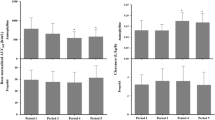Abstract
Purpose
It has been reported that oral valproate (VPA) reduces the dose of propofol required for sedation. As a potential reason for this, it is considered that VPA displaces serum protein-bound propofol and increases the proportion of protein-unbound-free propofol. To examine this hypothesis, the present in vitro study investigated the influence of VPA on the proportion of protein-unbound-free propofol in human serum samples.
Methods
Serum samples were collected from 10 healthy volunteers, who were not taking any medication. VPA (final concentration: 0.05, 0.1 or 1 mg/mL) and propofol (final concentration: 1 or 5 µg/mL) were mixed with serum samples with normal (4.0 g/dL) or low (2.5 g/dL) albumin concentrations. Then, protein-unbound-free propofol was extracted from the samples, and its concentration was measured using high-performance liquid chromatography. We compared the proportion of protein-unbound-free propofol in each of the VPA-containing samples with that in serum samples without VPA (control).
Results
In the serum samples with normal albumin concentrations, 1 mg/mL VPA significantly increased the proportion of protein-unbound-free propofol at 1 and 5 µg/mL propofol. Furthermore, in the serum samples with low albumin concentrations, the proportion of protein-unbound-free propofol was significantly increased by both 0.1 and 1 mg/mL VPA at propofol concentrations of 1 and 5 µg/mL.
Conclusion
VPA might increase the proportion of protein-unbound-free propofol in human serum via displacement reactions.



Similar content being viewed by others
References
van Blarikom W, Tan IY, Aldenkamp AP, van Gennep AT. Epilepsy, intellectual disability, and living environment: a critical review. Epilepsy Behav. 2006;9:14–8.
Perucca E. Pharmacologocal and therapeutic properties of valproate. A summary after 35 years of clinical experiences. CNS Drugs. 2002;16:695–714.
Ishii M, Higuchi H, Maeda S, Tomoyasu Y, Egusa M, Miyawaki T. The influence of oral VPA on the required dose of propofol for sedation during dental treatment in patients with mental retardation: a prospective observer-binded cohort study. Epilepsia. 2012;53:e13–6.
Hızlı Sayar G, Eryılmaz G, Semieoğlu S, Ozten E, Göğcegöz Gül I. Influence of valproate on the required dose of propofol for anesthesia during electroconvulsive therapy of bipolar affective disorder patients. Neuropsychiatr Dis Treat. 2014;10:433–8.
Wen X, Wang JS, Kivistö KT, Neuvonen PJ, Backman JT. In vitro evaluation of valproic acid as an inhibitor of human cytochrome P450 isoforms: preferential inhibition of cytochrome P450 2C9 (CYP2C9). Br J Clin Pharmacol. 2001;52:547–53.
Ethell BT, Anderson GD, Burchell B. The effect of valproic acid on drug and steroid glucuronidation by expressed human UDP-glucuronosyltransferases. Biochem Pharmacol. 2003;65:1441–9.
Hiraoka H, Yamamoto K, Miyoshi S, Morita T, Nakamura K, Kadoi Y, Kunimoto F, Horiuchi R. Kidneys contribute to the extrahepatic clearance of propofol in humans, but not lungs and brain. Br J Clin Pharmacol. 2005;60(2):176–82.
Johannessen CU, Johannessen SI. Valproate: past, present, and future. CNS Drug Rev. 2003;9(2):199–216.
Gin T. Pharmacodynamics of propofol and free drug concentrations. Anesthesiology. 1993;78(3):604–5.
Ohmori J, Maeda S, Higuchi H, Ishii M, Arai Y, Tomoyasu Y, Kohjitani A, Shimada M, Miyawaki T. Propofol increases the rate of albumin-unbound-free midazolam in serum albumin solution. J Anesth. 2011;25:618–20.
Dawidowicz AL, Kalitynski R, Kobielski M, Pieniadz J. Influence of propofol concentration in human plasma on free fraction of the drug. Chem Biol Interact. 2006;159(2):149–55.
Mather LE, Selby DG, Runciman WB, McLean CF. Propofol: Assay and regional mass balance in the sheep. Xenobiotica. 1989;19(11):1337–47.
MacKichan JJ. Protein binding during drug displacement interactions fact or fiction? Clin Pharmacokinet. 1989;16:65–73.
Gin T, Yau G, Jong W, Tan P, Leung RK, Chan K. Disposition of propofol at caesarean section and in the postpartum period. Br J Anaesth. 1991;67(1):49–53.
Leslie K, Crankshaw DP. Potency of propofol for loss of consciousness after a single dose. Br J Anaesth. 1990;64(6):734–6.
Kwong TC. Free drug measurements: methodology and clinical significance. Clin Chim Acta. 1985;151:193–216.
Dhillon S, Richens A. Valproic acid and diazepam interaction in vivo. Br J Clin Pharmacol. 1982;13:553–60.
Bhattacharya AA, Curry S, Franks NP. Binding of the general anesthetics propofol and halothane to human serum albumin: high resolution crystal structures. J Biol Chem. 2000;275:38731–8.
Patsalos PN, Berry DJ, Bourgeois BF, Cloyd JC, Glauser TA, Johannessen SI, Leppik IE, Tomson T, Perucca E. Antiepileptic drugs-best practice guidelines for therapeutic drug monitoring: a position paper by the subcommission on therapeutic drug monitoring, ILAE Commission on Therapeutic Strategies. Epilepsia. 2008;49:1239–76.
American Psychiatric Association. Practice guideline for the treatment of patients with bipolar disorder. Am J Psychiatry. 2002;159(4 Suppl):1–50.
Takizawa D, Takizawa E, Miyoshi S, Kawahara F, Hiraoka H. The increase in total and unbound propofol concentrations during accident hemorrhagic shock in patients undergoing liver transplantation. Anesth Analg. 2006;103:1339–40.
Hiraoka H, Yamamoto K, Okano N, Morita T, Goto F, Horiuchi R. Changes in drug plasma concentrations of an extensively bound and highly extracted drug, propofol, in response to altered plasma binding. Clin Pharmacol Ther. 2004;75:324–30.
Takizawa D, Sato E, Kurosaki D, Hiraoka H, Horiuchi R, Goto F. Pharmacodynamics of propofol during hemorrhagic shock. Anesthesiology. 2005;102:1068–9.
Mazoit JX, Samii K. Binding of propofol to blood components: implications for pharmacokinetics and for pharmacodynamics. Br J Clin Pharmacol. 1999;47(1):35–42.
Takizawa E, Hiraoka H, Takizawa D, Goto F. Changes in the effect of propofol in response to altered plasma protein binding during normothermic cardiopulmonary bypass. Br J Anaesth. 2006;96:179–85.
Kojima A, Bai JY, Ito Y, Ding WG, Kitagawa H, Matsuura H. Serum albumin attenuates the open-channel blocking effects of propofol on the human Kv1.5 channel. Eur J Pharmacol. 2016;783:117–26.
Gomez MJ, Santos Buelga D, Alonso AC, Garcia MJ, Dominguez-Gil A. Effect of dose on the kinetic behaviour of valproic acid: modifications in plasma protein binding. Eur J Drug Metab Pharmacokinet. 1991;3:239–42.
Funding
The present study was supported by institutional funding of Okayama University Graduate School of Medicine, Dentistry and Pharmaceutical Sciences and a Grant-in-Aid for Young Scientists (B) (24792214) from the Japan Society for Promotion of Science.
Author information
Authors and Affiliations
Corresponding author
About this article
Cite this article
Ishii-Maruhama, M., Higuchi, H., Nakanou, M. et al. In vitro changes in the proportion of protein-unbound-free propofol induced by valproate. J Anesth 32, 688–693 (2018). https://doi.org/10.1007/s00540-018-2540-6
Received:
Accepted:
Published:
Issue Date:
DOI: https://doi.org/10.1007/s00540-018-2540-6




